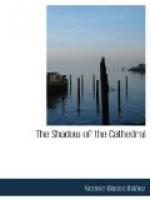Many mornings he would go to the Muzarabe Chapel, following attentively the ancient ritual,[1] intoned by the priests especially devoted to it. On the walls were represented in brilliant colours scenes from the conquest of Oran by the great Cisneros. As Gabriel listened to the monotonous singing of the Muzarabe priests he remembered the quarrels during the time of Alfonso VI. between the Roman liturgy and that of Toledo—the foreign worship and the national one. The believers, to end the eternal disputes, appealed to the “Judgment of God.” The king named the Roman champion, and the Toledans confided the defence of their Gothic rite to the sword of Juan Ruiz, a nobleman from the borders of Pisuerga. The champion of the Gothic breviary remained triumphant in the fight, demonstrating its superiority with magnificent sword thrusts, but, in spite of the will of God having been manifested in this warlike way, the Roman rite by slow degrees became master of the situation, till at last the Muzarabe ritual was relegated to this small chapel as a curious relic of the past.
[Footnote 1: The Muzarabe ritual is still sung in Arabic both in Toledo and Salamanca.]
Sometimes in the evenings, when the services were ended and the Cathedral was locked up, Gabriel would go up to the abode of the bell-ringer, stopping on the gallery above the door del Perdon. Mariano, the bell-ringer’s son, a youth of the same age as the seminarist, and attached to him by the respect and admiration his talents inspired, would act as guide in their excursions to the upper regions of the church; they would possess themselves of the key of the vaultings and explore that mysterious locality to which only a few workmen ascended from time to time.
The Cathedral was ugly and commonplace seen from above. In the very early days the stone vaultings had remained uncovered, with no other concealment beyond the light-looking carved balustrade, but the rain had begun to damage them, threatening their destruction, and so the Chapter had covered the Cathedral with a roof of brown tiles, which gave the Church the appearance of a huge warehouse or a great barn. The pinnacles of the buttresses seemed ashamed to appear above this ugly covering, the flying buttresses became lost and disappeared among the bare-looking buildings, built on to the Cathedral, and the little staircase turrets became hidden behind this clumsy mass of roofing.
The two youths climbing along the cornices, green and slippery from the rain, would mount to quite the upper parts of the building. Their feet would become entangled in the plants that a luxuriant nature allowed to grow amid the joints of the stones, flocks of birds would fly away at their approach; all the sculptures seemed to serve as resting-places for their nests, and every hollow in the stone where the rain-water collected was a miniature lake where the birds came to drink; sometimes a large black bird would settle on one of the pinnacles like an unexpected finial; it was a raven who settled there to plume his wings, and it would remain there sunning itself for hours; to the people who saw it from below it appeared about the size of a fly.




